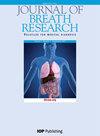Generating pooled quality control samples of volatile organic compounds.
IF 3.4
4区 医学
Q1 BIOCHEMICAL RESEARCH METHODS
引用次数: 0
Abstract
Untargeted analysis of volatile organic compounds (VOCs) from exhaled breath and culture headspace can be influenced by several confounding factors that are not reflected in reference standards. In this study, we propose a method to generating pooled quality control (QC) samples for untargeted VOC studies using a split-recollection workflow for thermal desorption tubes. Sample tubes were desorbed with a 10% split from each sample and recollected onto a single tube, generating a pooled QC sample. This QC sample was then repeatedly desorbed and recollected with a sequentially lower split ratio allowing injection of up to ten QC samples. We found pooled QC samples to be representative of complex mixtures using principal component analysis (PCA) and may be useful in future longitudinal, multi-centre, and validation studies to assess data quality and adjust for batch effects.生成挥发性有机化合物的集合质量控制样本。
对呼出气体和培养顶空气中的挥发性有机化合物(VOCs)进行非靶向分析可能会受到参考标准中未反映的多种干扰因素的影响。在本研究中,我们提出了一种方法,利用热脱附试管的分割采集工作流程,为非目标挥发性有机化合物研究生成集合质控(QC)样品。样品管从每个样品中分离出 10%进行解吸,然后重新收集到单个样品管上,生成一个集合质控样品。然后重复解吸该质控样本,并以依次降低的分样率重新收集,最多可注入 10 个质控样本。通过主成分分析(PCA),我们发现汇集的质控样本能够代表复杂的混合物,在未来的纵向、多中心和验证研究中可用于评估数据质量和调整批次效应。
本文章由计算机程序翻译,如有差异,请以英文原文为准。
求助全文
约1分钟内获得全文
求助全文
来源期刊

Journal of breath research
BIOCHEMICAL RESEARCH METHODS-RESPIRATORY SYSTEM
CiteScore
7.60
自引率
21.10%
发文量
49
审稿时长
>12 weeks
期刊介绍:
Journal of Breath Research is dedicated to all aspects of scientific breath research. The traditional focus is on analysis of volatile compounds and aerosols in exhaled breath for the investigation of exogenous exposures, metabolism, toxicology, health status and the diagnosis of disease and breath odours. The journal also welcomes other breath-related topics.
Typical areas of interest include:
Big laboratory instrumentation: describing new state-of-the-art analytical instrumentation capable of performing high-resolution discovery and targeted breath research; exploiting complex technologies drawn from other areas of biochemistry and genetics for breath research.
Engineering solutions: developing new breath sampling technologies for condensate and aerosols, for chemical and optical sensors, for extraction and sample preparation methods, for automation and standardization, and for multiplex analyses to preserve the breath matrix and facilitating analytical throughput. Measure exhaled constituents (e.g. CO2, acetone, isoprene) as markers of human presence or mitigate such contaminants in enclosed environments.
Human and animal in vivo studies: decoding the ''breath exposome'', implementing exposure and intervention studies, performing cross-sectional and case-control research, assaying immune and inflammatory response, and testing mammalian host response to infections and exogenous exposures to develop information directly applicable to systems biology. Studying inhalation toxicology; inhaled breath as a source of internal dose; resultant blood, breath and urinary biomarkers linked to inhalation pathway.
Cellular and molecular level in vitro studies.
Clinical, pharmacological and forensic applications.
Mathematical, statistical and graphical data interpretation.
 求助内容:
求助内容: 应助结果提醒方式:
应助结果提醒方式:


